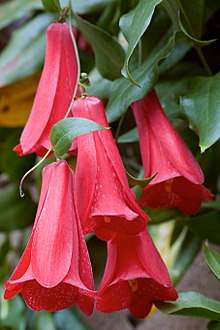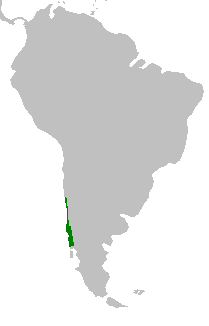Lapageria
Lapageria is a genus of flowering plants with only one known species, Lapageria rosea, commonly known as Chilean bellflower or copihue (co-pee-way < Mapudungun kopiwe).[2] Lapageria rosea is the national flower of Chile. It grows in forests in the southern part of Chile, being part of the Valdivian temperate rain forests flora.
| Lapageria | |
|---|---|
 | |
| Scientific classification | |
| Kingdom: | Plantae |
| Clade: | Tracheophytes |
| Clade: | Angiosperms |
| Clade: | Monocots |
| Order: | Liliales |
| Family: | Philesiaceae |
| Genus: | Lapageria Ruiz & Pav. |
| Species: | L. rosea |
| Binomial name | |
| Lapageria rosea Ruiz & Pav. | |
 | |
| Distribution area of Lapageria rosea | |
| Synonyms[1] | |
| |
Botany
Lapageria rosea is related to Philesia magellanica (syn. P. buxifolia), another plant from the Valdivian flora, having similar flowers, but shrubby rather than climbing. ×Philageria veitchii is a hybrid between L. rosea and P. magellanica. It is more similar in appearance to the former.
Growth habit
Lapageria rosea is an evergreen climbing plant reaching over 10 m high among shrubs and trees. The leaves are arranged alternately and are evergreen, leathery, lanceolate and feature three to seven prominent parallel veins. The vines twine counterclockwise in the Southern hemisphere and clockwise when grown in the Northern hemisphere (likely due to the Sun).
The flowers have six thick, waxy tepals which are red, spotted with white. They are most frequently produced in late summer and fall, although they may be produced at other times. The fruit is an elongated berry with a tough skin containing numerous small seeds about the size of a tomato seed, which are covered in an edible fleshy aril. In the wild the plant is pollinated by hummingbirds.
Pollen is distributed by birds, insects and other animals. Insect pollinators include: Bombus dahlbomii (native species to southern South America) and Bombus terrestris and Bombus ruderatus (both of which are not native to southern South America, and, instead, invasive).[3][4]
Historical usage
In the past its fruit was sold in markets, but the plant has now become rare through over-collection and forest clearance.
The roots were once collected and used as a substitute for sarsaparilla. In 1977 the plant was given legal protection in Chile.
Etymology
Lapageria is named for Marie Joséphine Rose Tascher de la Pagerie (1763-1814), also known as Napoleon's Empress Josephine, who was a keen collector of plants for her garden at Château de Malmaison.[5] Rosea means 'flushed rose' or 'flushed pink'.[5]
The name of the fruit in Mapudungun is actually kopiw (derived from kopün, "to be upside down"), which is the etymon of Spanish copihue; the Mapuche call the plant kolkopiw (colcopihue in Spanish, which may also refer to the whole plant). The flower is called kodkülla in the indigenous language.[2]
Cultivation
The plant was introduced to Europe by William Lobb during his plant collecting expedition to the Valdivian temperate rain forests in 1845–1848 and was growing at Kew in 1847.[6]
In cultivation the plant requires a shaded, sheltered position with acid or neutral soil. It is hardy down to −5 °C (23 °F), so in the UK can be grown outside in mild or coastal areas. It has gained the Royal Horticultural Society's Award of Garden Merit.[7][8]
Cultivars
There are numerous named garden cultivars, mostly developed at one nursery in Chile, with flower colour varying from deep red through pink to pure white (L. rosea 'Albiflora'), and some with variegated flowers.
In the United States, UC Botanical Garden at the University of California at Berkeley has one of the largest collections of the Lapageria genus with around 24 named and unnamed cultivars in its collection. This collection was started by T Harper Goodspeed, botany professor at UCB and alternately curator or director of the gardens from 1919–1957. The University established a relationship with El Vergel Farm, a Methodist mission and agricultural school in Angol, Chile which housed the largest collection of named cultivars and wild lapagerias in the world.[9]
Propagation
To obtain fruit in cultivation it is generally necessary to pollinate by hand if there are not native hummingbirds. Chilean bellflower can be propagated from cuttings, layering and fresh seeds.[10] Some cultivars are self-fruitful, but better pollination is achieved with differing parents. Germination is best with fresh moist seed; dried seeds take special treatment and have a much poorer germination rate. Propagation of cultivars is by cuttings (usually rooted under mist), layering, or division. Seedlings take from three to ten years to flower. Cuttings usually flower more quickly.
Gallery
 Lapageria Rosea, by Helga von Cramm, with verse by F.R. Havergal, 1870s.
Lapageria Rosea, by Helga von Cramm, with verse by F.R. Havergal, 1870s. Stem twining counterclockwise
Stem twining counterclockwise Buds in the Temperate House at the Royal Botanic Gardens, Kew
Buds in the Temperate House at the Royal Botanic Gardens, Kew
Foliage
References
- Kew World Checklist of Selected Plant Families
- Muñoz Urrutia, Rafael, ed. (2006). Diccionario Mapuche: Mapudungun/Español, Español/Mapudungun (in Spanish) (2nd ed.). Santiago, Chile: Editorial Centro Gráfico. pp. 41, 155. ISBN 978-956-8287-99-3.
- Murúa, Maureen M; Grez, Audrey A; Simonetti, Javier A (2011). "Changes in wing length in the pollinator Bombus dahlbomii occurring with the fragmentation of the Maulino forest, Chile". Ciencia e Investigación Agraria. 38 (3): 391. doi:10.4067/S0718-16202011000300008.
- Morales, C. L., et al. (2004). "Potential displacement of the native bumblebee Bombus dahlbomii by the invasive Bombus ruderatus in NW Patagonia, Argentina", pp. 70-76 in Proceedings of the 8th IBRA International Conference on Tropical Bees and VI Encontro sobre Abelhas, Ribeirão Preto, Brasil, September 6–10, 2004.
- Gledhill, David (2008). "The Names of Plants". Cambridge University Press. ISBN 9780521866453 (hardback), ISBN 9780521685535 (paperback). pp 230, 334
- Sue Shephard (2003). Seeds of Fortune - A Gardening Dynasty. Bloomsbury. p. 100. ISBN 0-7475-6066-8.
- "RHS Plant Selector - Lapageria rosea". Royal Horticultural Society. Archived from the original on 19 October 2013. Retrieved 20 May 2013.
- "AGM Plants - Ornamental" (PDF). Royal Horticultural Society. July 2017. p. 58. Retrieved 19 March 2018.
- http://www.PacificHorticulture.com/articles/ilapageria-roseai
- , Lapageria rosea,The Lovely Plants
Bibliography
- Crandall, Chuck; Crandall, Barbara (1995). Flowering, Fruiting & Foliage Vines: a gardener's guide. New York: Sterling Publishing. ISBN 978-0-8069-0726-0. (Page 9 in the book illustrates clockwise and counterclockwise twining.)
- Grez, Audrey A; Bustamante, Ramiro O; Simonetti, Javier A & Fahrig, Lenore (1998). "Landscape Ecology, Deforestation, and Forest Fragmentation: the Case of the Ruil Forest in Chile". In Salinas Chávez, Eduardo & Middleton, John (eds.). Landscape Ecology as a Tool for Sustainable Development in Latin America. Brock University, California. Retrieved 23 April 2012.
- Reed, Elbert E (1964). "The Chilean Bellflower, Copihue, Lapageria rosea". California Horticultural Society Journal. 25 (3).
- Riedemann, Paulina; Aldunate, Gustavo (2003). Flora nativa de valor ornamental : Chile zona sur (in Spanish). Santiago de Chile: Editorial Andres Bello. ISBN 978-956-13-1827-4.
- Ruiz, Hippolyto; Pavon, Josepho (1802). Flora Peruviana et Chilensis.
- Song, Leo. "Lapageria rosea, La Flor Nacional de Chile". Missing or empty
|url=(help) Reproduced at "lapageria pages". Retrieved 23 April 2012.
External links
| Wikimedia Commons has media related to Lapageria rosea. |